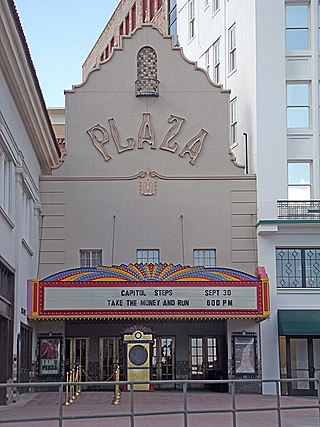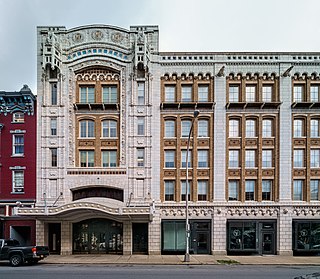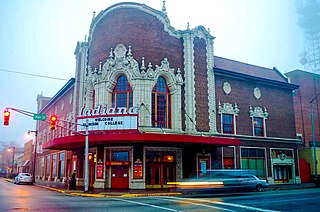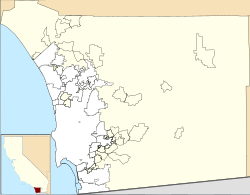
The Castro Theatre is a historic movie palace in the Castro District of San Francisco, California. The venue became San Francisco Historic Landmark #100 in September 1976. Located at 429 Castro Street, it was built in 1922 with a California Churrigueresque façade that pays homage—in its great arched central window surmounted by a scrolling pediment framing a niche—to the basilica of Mission Dolores nearby. Its designer, Timothy L. Pflueger, also designed Oakland's Paramount Theater and other movie theaters in California during that period. The theater has more than 1,400 seats.

The Hawaii Theatre is a historic 1922 theatre in downtown Honolulu, Hawaii, located at 1130 Bethel Street, between Hotel and Pauahi Streets, on the edge of Chinatown. It is listed on the State and National Register of Historic Places.

The Alabama Theatre is a movie palace in Birmingham, Alabama. It was built in 1927 by Paramount's Publix Theatres chain as its flagship theater for the southeastern region of the United States. Seating 2,500 people at the time, it was the largest in the Birmingham theater district. The district was once home to many large theaters and movie palaces that featured vaudeville, performing arts, nickelodeons and Hollywood films. Built to show silent films, the Alabama still features its original Wurlitzer theater organ. The Alabama Theatre and Lyric Theatre are the district's only remaining theaters, and as of 2024, both are in operation.

The Fox Theatre is a performing arts center located at 2211 Woodward Avenue in Downtown Detroit, Michigan, near the Grand Circus Park Historic District. Opened in 1928 as a flagship movie palace in the Fox Theatres chain, it was at over 5,000 seats the largest theater in the city. Designed by theater architect C. Howard Crane, it was listed on the National Register of Historic Places in 1985.

The Kings Theatre, formerly Loew's Kings Theatre, is a live performance venue in the Flatbush neighborhood of Brooklyn, New York City. Opened by Loew's Theatres as a movie palace in 1929 and closed in 1977, the theater sat empty for decades until a complete renovation was initiated in 2010. The theater reopened to the public on January 23, 2015 as a performing arts venue. It was listed on the National Register of Historic Places on August 22, 2012.

The Paramount Theatre is a 1,693-seat theater in Cedar Rapids, Iowa. It was individually listed on the National Register of Historic Places in 1976. In 2015 it was included as a contributing property in the Cedar Rapids Central Business District Commercial Historic District.

Horton Plaza was a five-level outdoor shopping mall in downtown San Diego. It was designed by Jon Jerde and was known for its bright colors, architectural tricks, and odd spatial rhythms, occupying 6.5 city blocks adjacent to the city's historic Gaslamp Quarter. Opening in 1985, it was the first successful downtown retail center since the rise of suburban shopping centers decades earlier.

Saenger Theatre is an atmospheric theatre in downtown New Orleans, Louisiana, which is on the National Register of Historic Places. Once the flagship of Julian and Abe Saenger's theatre empire, today it is one of only a handful of Saenger movie palaces that remain.

Keith-Albee Theatre is a performing arts center located along Fourth Avenue in downtown Huntington, West Virginia, United States. The Keith-Albee was named after the Keith-Albee-Orpheum Corporation, one of the leading vaudeville performance chains at that time, to convince the directors of Keith-Albee-Orpheum to make the Keith-Albee a regular stop. At the time of its construction, The Keith Albee was the second largest theater in the U.S. It is listed on the National Register of Historic Places as part of the Downtown Huntington Historic District, and is currently being restored as a performing arts center.

The Plaza Theatre is a historic building in El Paso, Texas built in 1930. The theater stands as one of the city's most well-known landmarks, and remains operational today. The theatre is a National Historic Building of Significance featuring the 2,050-seat Kendall Kidd Performance Hall, and the smaller 200-seat Philanthropy Theatre. It hosts Broadway productions, musical concerts, individual performers and the annual Plaza Classic Film Festival.

An atmospheric theatre is a type of movie palace design which was popular in the late 1920s. Atmospheric theatres were designed and decorated to evoke the feeling of a particular time and place for patrons, through the use of projectors, architectural elements and ornamentation that evoked a sense of being outdoors. This was intended to make the patron a more active participant in the setting.

The Robert Morton Organ Company was an American producer of theater pipe organs and church organs, located in Van Nuys, California. Robert Morton was the number two volume producer of theatre organs, building approximately half as many organs as the industry leader Wurlitzer. The name Robert Morton was derived not from any person in the company, but rather from the name of company president Harold J. Werner's son, Robert Morton Werner.

Proctor's Theater is located on Fourth Street in Troy, New York, United States. It was listed on the National Register of Historic Places in 1979, and is a contributing property to the Central Troy Historic District, added to the Register in 1986.

The Orpheum Theatre, also known as New Orpheum Theatre and Orpheum Electric Building, is a performing arts center located at 528 S. Pierce Street in Sioux City, Iowa. Built in 1927 as a vaudeville and movie palace, the theatre was restored in 1999 and today is the home of the Sioux City Symphony Orchestra.

The Hilbert Circle Theatre, originally called the Circle Theatre, is in Indianapolis, Indiana, on Monument Circle in the Washington Street-Monument Circle Historic District. It was originally built in 1916 as a "deluxe movie palace" and now is the home of the Indianapolis Symphony Orchestra.

The Majestic Theatre is a performing arts theater in the City Center District of Downtown Dallas. It is the last remnant of Theater Row, the city's historic entertainment center on Elm Street, and is a contributing property in the Harwood Street Historic District. The structure is a Dallas Landmark and is listed on the National Register of Historic Places.

The Historic Ironwood Theatre is a theatre in Ironwood, Michigan offering a variety of live theatrical, musical, and artistic performances as part of its programming. The theatre is a non-profit entertainment establishment owned by the City of Ironwood and operated by Ironwood Theatre Inc., a non-profit organization led by volunteers who serve on the Board of Directors.

The Mississippi Lofts and Adler Theatre is an apartment building and theater complex located in downtown Davenport, Iowa, United States. It is individually listed on the National Register of Historic Places by its original name, the Hotel Mississippi and RKO Orpheum Theater. The Hotel Mississippi was listed on the Davenport Register of Historic Properties in 2005. In 2020 the complex was included as a contributing property in the Davenport Downtown Commercial Historic District.

Balboa Park is a 1,200-acre (490 ha) historic urban cultural park in San Diego, California, United States. In addition to open space areas, natural vegetation zones, green belts, gardens, and walking paths, it contains museums, several theaters, and the San Diego Zoo. There are also many recreational facilities and several gift shops and restaurants within the boundaries of the park. Placed in reserve in 1835, the park's site is one of the oldest in the United States dedicated to public recreational use. Balboa Park is managed and maintained by the Parks and Recreation Department of the City of San Diego.

The Indiana Theatre is a historic theater in Terre Haute, Indiana, United States. It was added to the National Register of Historic Places on November 13, 1997 and is located in the Wabash Avenue-East Historic District. It opened on January 28, 1922. The theatre was built by Terre Haute resident T. W. Barhydt and was designed by John Eberson. Eberson, who later developed the atmospheric theater style of movie palace, first experimented with atmospheric design elements at the theatre. Eberson stated, "Into this Indiana Theatre I have put my very best efforts and endeavors in the art of designing a modern theatre such as I have often pictured as what I would do were I given a free hand." Through this quote Eberson suggests that the Indiana Theatre embodies the raw beginning of his experiment with a "dream" theater that marked the beginning shift to his atmospheric style.



























